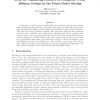13 search results - page 2 / 3 » Accumulators from Bilinear Pairings and Applications |
IACR
2011
12 years 4 months ago
2011
Abstract. In Asiacrypt 2010, Groth constructed the only previously known sublinearcommunication NIZK argument for circuit satisfiability in the common reference string model. We p...
IACR
2011
12 years 4 months ago
2011
In this paper, we explore a general methodology for converting composite order pairingbased cryptosystems into the prime order setting. We employ the dual pairing vector space app...
CIS
2005
Springer
13 years 10 months ago
2005
Springer
Restrictive blind signatures allow a recipient to receive a blind signature on a message not known to the signer but the choice of message is restricted and must conform to certain...
ACNS
2005
Springer
13 years 10 months ago
2005
Springer
k-times anonymous authentication (k-TAA) schemes allow members of a group to be anonymously authenticated by application providers for a bounded number of times. k-TAA has applicat...
EUROCRYPT
2009
Springer
14 years 5 months ago
2009
Springer
A group key agreement (GKA) protocol allows a set of users to establish a common secret via open networks. Observing that a major goal of GKAs for most applications is to establish...

